Book contents
- Frontmatter
- Contents
- Foreword by Sir Kenneth Calman
- Introduction
- List of Illustrations
- Acknowledgements
- Abbreviations used in the Notes
- Dedication
- 1 William Hunter's Life and Career
- 2 Growth of the Hunterian Collection
- 3 ‘The Noblest Legacy upon Record’
- 4 A Temple of the Muses: the First Hunterian Museum in Glasgow
- 5 ‘This Place of Fascination’: the Impact of the Museum, 1807–70
- 6 A New Museum for a New University, 1870–1900
- 7 The Twentieth Century: War, Peace and Renewal, 1900–75
- 8 The Hunterian Art Gallery
- 9 Modern Times, 1975–2007
- 10 Overview: Meeting William Hunter's Intentions
- Postscript: Looking to the Future
- Notes
- Appendix: Catalogues of the Hunterian Collections
- Bibliography
- Index
- Plate section
Foreword by Sir Kenneth Calman
Published online by Cambridge University Press: 12 September 2012
- Frontmatter
- Contents
- Foreword by Sir Kenneth Calman
- Introduction
- List of Illustrations
- Acknowledgements
- Abbreviations used in the Notes
- Dedication
- 1 William Hunter's Life and Career
- 2 Growth of the Hunterian Collection
- 3 ‘The Noblest Legacy upon Record’
- 4 A Temple of the Muses: the First Hunterian Museum in Glasgow
- 5 ‘This Place of Fascination’: the Impact of the Museum, 1807–70
- 6 A New Museum for a New University, 1870–1900
- 7 The Twentieth Century: War, Peace and Renewal, 1900–75
- 8 The Hunterian Art Gallery
- 9 Modern Times, 1975–2007
- 10 Overview: Meeting William Hunter's Intentions
- Postscript: Looking to the Future
- Notes
- Appendix: Catalogues of the Hunterian Collections
- Bibliography
- Index
- Plate section
Summary
This book is the story of one man and his passion for collecting, and his museum and how it has survived and grown over the years. William Hunter was a remarkable man and with his brother John broke the mould of medicine and medical education in the latter part of the eighteenth century. They were both avid collectors and Glasgow is fortunate that William's collection came to the University.
In this book his passion and determination to collect are evident, and he would go to very high prices to get what he wanted. This was not as an investment but to support his medical work and enhance knowledge of related branches of medical science. This has always been an important part of the work of the Museum, and throughout its history the need to ensure public access has been a recurring theme, from Great Windmill Street to Gilmorehill.
The stories in this book are fascinating. If the way to a man's heart is through his stomach, then the way to a collector's heart is to tempt him with something he might like to acquire. The story of John Murray, a Scottish publisher recently arrived in London, using this trick to become William's publisher is just one of them, and of course Murray's archive of wonderful letters will soon be in the National Library of Scotland.
William had always wanted to do something special at Glasgow though his plans to set up a medical school with William Cullen failed.
- Type
- Chapter
- Information
- William Hunter and the Hunterian Museum in Glasgow 1807–2007 , pp. vi - viiPublisher: Edinburgh University PressPrint publication year: 2007

